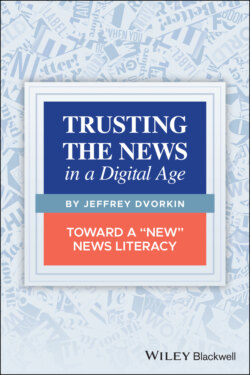Читать книгу Trusting the News in a Digital Age - Jeffrey Dvorkin - Страница 31
From Media Trust to Media Mistrust
ОглавлениеThe election of Donald J. Trump as President of the United States has heightened the sense of crisis in journalism. Even as some media organizations – both legacy and independent – have given citizens some of the best reporting in years, the economic threat to journalism is now coupled with the attacks – both physical and verbal – on journalists in America and elsewhere.
Trump's election changed journalism in other ways, as well. For many media organizations in America, especially, the gloves are off. The assumption that fact‐based journalism is professionally neutral has been stripped away. Instead of the traditional “stenographic” approach to reporting – or reporting basic facts without much contextualization – we are now seeing the rise of opinion‐based reporting – or reporting that is, in the tradition of the talk radio that emerged in the 1980s, highly editorialized and confrontational – instead. This form of journalism, when combined with a new populist quality (some of the British press has always acted as an agent of popular sentiment), fueled by the Internet, has resulted in a revolt against what some components who rail against “fake news” call the liberal media elites.
Opinion journalism has an additional advantage: it is less costly to produce. Talk radio and cable TV thrived in this atmosphere and continue to do so.
This has been building for many years, as media organizations – both print and broadcast – have discovered that having point‐of‐view journalists in the studio and columnists – both types of reporters who independently gather news and who also share their perspective and agenda – is less expensive than a news bureau – a centralized office where a news organization gathers and distributes all of its news. Investigative reporting units inside news organizations have been stripped down or abandoned completely and replaced by mills for more popular content. News organizations, driven more by delivering dividends to shareholders, worry about lawsuits and damage to reputation.
Complicit in this downgrading of reportage has been the eager collusion of news consultants who have pushed the quality of journalism into a more tabloid and down‐market phase. These consultants, also known as “news doctors,” became a ubiquitous presence inside news organizations. Brought in to find ways to improve efficiencies and maximize audience numbers, they often found themselves at loggerheads with an entrenched newsroom culture that opposed the increasing influence of digital technologies.
Many legacy news organizations now feel that circumstances, along with the public sensibility, force them to provide “journalism with an edge.” Old ways of journalism are being rapidly changed and even abandoned.
“Discard the ossified practices of objectivity…”
Pinar Gurleyen and Robert Hackett, two Canadian academics, make a strong argument that journalism needs to “discard some of the ossified practices of objectivity that stifle political understanding and engagement…” (2016, p. 51). In other words, journalism needs to have a viewpoint and a purpose. This proposal is appealing yet fraught with unintended consequences, including the replacement of fact‐based reporting with more opinion journalism. While there is a place for considered opinion, the risk remains that more opinion and less evidence‐based reporting would not serve the information needs of citizens who still need reliable information more than ever, especially at the local level. More opinion journalism can allow for the intrusion of advocacy and “fake news” into the media landscape.
